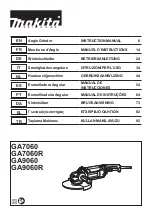
Page
22
/
41
3.5- Specific Safety Instructions for grinding and cutting operation
a- Use only disk types that are recommended for your tool and the specific guard designed for
the selected disk.
Disks
for which the tool was not designed cannot be adequately guarded and are
unsafe.
b- The guard must be securely attached to the power tool and positioned for maximum safety,
so the least amount of wheel is exposed towards the operator. The guard helps to protect
operator from broken wheel fragments and accidental contact with wheel and sparks that could
ignite clothing.
c- Disks must be used only for their recommended applications. For example: do not grind with
the side of the cut-off disk. Abrasive cut-off disks are intended for peripheral grinding; side forces
applied to these disks may cause them to shatter.
d- Always use undamaged disk flanges that are of correct size and shape for your selected
disk. Proper disk flanges support the disk thus reducing the possibility of disk breakage. Flanges
for cut-off disks may be different from grinding disk flanges.
e- Do not use worn out disks from larger power tools.
Disks intended for larger power tools are
not suitable for the higher speed of a smaller tool and may burst.
3.6- Specific Safety Instructions for abrasive cutting operations
a- Do not “jam” the cut-off disk or apply excessive pressure. Do not attempt to make an
excessive depth cut. Overstressing the disk increases the loading and susceptibility to twisting or
binding of the disk in the cut and the possibility of kickback or disk breakage.
b- Do not position your body in line with and behind the rotating disk. When the disk, at the
point of operation, is moving away from your body, the possible kickback may propel the rotating
disk and the tool directly at you.
c- When the disk is binding or when you interrupt a cut for any reason, switch off the power
tool and hold the power tool motionless until the rotating disk comes to a complete stop.
Never attempt to remove the cut-off disk from the cut while the disk is still in motion,
otherwise kickback may occur. Investigate and take corrective action to eliminate the cause of
disk binding.
d- Do not restart the cutting operation in the workpiece. Let the disk reach full speed and
carefully reenter the cut. The disk may bind, walk up or kickback if the power tool is restarted in
the workpiece.
e- Support panels or any oversized workpiece to minimize the risk of disk pinching and
kickback. Large workpieces tend to sag under their own weight. Supports must be placed under
the workpiece near the line of cut and near the edge of the workpiece on both sides of the disk.
f- Use extra caution when making a “pocket cut” into existing walls or other blind areas. The
protruding wheel may cut gas or water pipes, electrical wiring or objects that can cause kickback.
3.7- Specific Safety Instructions for sanding operations
Do not use oversized sandpaper pads for sanding discs.
Follow manufacturers' recommendations when selecting sandpaper.
Larger sandpaper protruding beyond the sanding pad presents a laceration hazard and may cause
a fixing, tear the disc or a kickback.
3.8- Specific Safety Instructions for wire brush operations
a- Keep in mind that metal strands are ejected by the wire brush even during ordinary
operation.
Do not subject the metal wires to excessive stress by applying excessive load onto the brush.
The metal strands can easily penetrate light clothing and / or skin.
b- If the use of a protective cover is recommended for wire brushing, prevent the cup brush
or wire brush to hinder on the protective cover.
The cup brush or wire brush may expand in diameter due to the workload and centrifugal forces.
















































